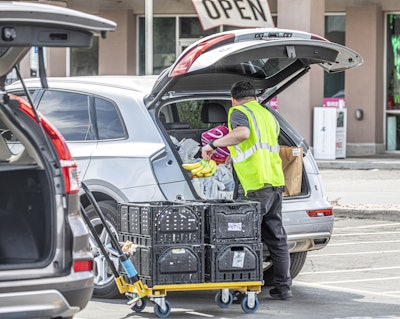
The U.S. online grocery market declined 3.1% in September vs. last year, ending the month with $7.5 billion in sales, according to the latest monthly Brick Meets Click/Mercatus Grocery Shopping Survey. Declines in order frequency and spending per order contributed to the drop while an expanded base of monthly users softened the slip in overall sales and signaled continued interest in buying groceries online.
“Both pickup and Walmart are growing share in today’s market for a range of reasons,” says David Bishop, partner at Brick Meets Click. “Each helps customers who are searching for ways to save money while pickup provides more flexibility as to when an order is received by the customer compared to delivery.”
“Motivating customers to shop with you again online may be challenging – especially when many households are trying to stretch a buck – but attracting new ones is even harder,” says Sylvain Perrier, president and CEO, Mercatus. “To compete more effectively, in addition to promoting more types of money-saving offers such as loyalty rewards, bundled deals, or other promotions, grocers can emphasize the quality, service, and convenience they offer that big-box retailers don’t.”
Key takeaways:
- Most of the sales decline was driven by contractions in order frequency as the average number of orders per monthly active user (MAU) fell 8% vs. a year ago. September finished at 2.31, the lowest order rate since the COVID-19 pandemic disrupted grocery shopping patterns. And, while September’s order frequency remains above pre-COVID-19 levels, it was only about 14% higher than the 2.03 orders per month posted in August 2019.
- The drop in overall order frequency resulted from shifts in shopper behavior. The share of MAUs who completed only one order during the month jumped to nearly 37%, the highest level since pre-COVID-19. At the same time, the share of MAUs making three or more orders contracted 370 bps on a year-over-year basis, continuing a downward trend which was also observed between 2021-2022.
- The downward movement in order frequency impacted most retail formats to varying degrees. Mass retailers experienced a 4% decline in order frequency among its MAU base, while Amazon’s pure-play segments dropped 7% and supermarkets fell nearly 13% in September vs. a year ago.
- All three receiving methods -- pickup, delivery, and ship-to-home -- experienced growth in their respective MAU bases as the total number of households completing at least one order during the month jumped almost 11% compared to September 2022. This jump more than offset the order frequency decline and drove a nearly 2% gain in total order volume.
- Pickup posted its highest household penetration to date during September, climbing to 59% of MAUs, driven by increased reach in all households but the youngest (<30) age group. Meanwhile, delivery and ship-to-home both experienced contractions in penetration versus last year, finishing at 39% and 40% respectively.
- Cross-shopping rates between grocery (which includes supermarket and hard discount retailers) and mass continued to climb, increasing 40 basis points vs. last year to finish the month at 28%. And the gap in repeat rates between these two formats was halved vs. September 2022, as the share of grocery customers who indicated they are extremely or very likely to use the same service next month slipped 340 bps to 52% while for mass it dropped 860 bps to 57%.
- Online sales across all formats accounted for 12.6% based on total weekly grocery spending during the last week of September, climbing 160 bps vs. last year.





















